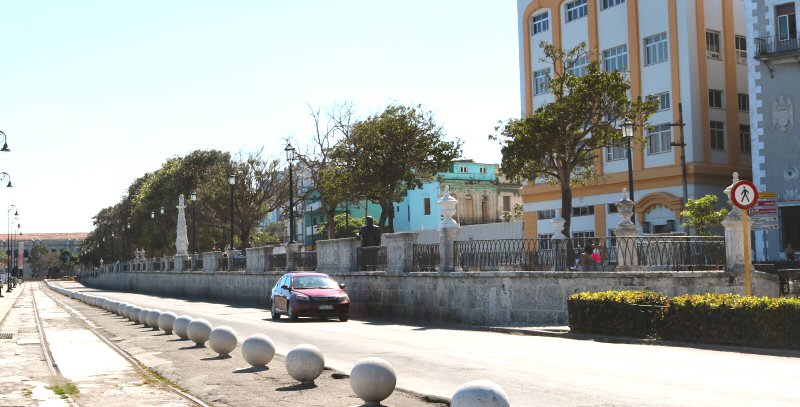
The Alameda Paula is a promenade, located between the San Pedro street and the Avenida del Puerto (Desamparados), extending from the Parque Aracelo Iglesias to the Iglesia de San Francisco de Paula.
At present the Alameda de Paula
looks like a tree-lined short boulevard, remaining as an
island of historical relic between the Avenida San Pedro and
the Avenida del Puerto (Desamparados). It runs about 400
meters long parallel to the Avenida del Puerto. Despite the
attritional effect of the time, it still retains its charm by
the lampposts, the fountain and the sea view. The white
marble of the fountain is in great contrast with the dark
grey color of the asphalt road around. It is like a long
platform, a few hand spans above the street level. The
benches are occupied by flirting young people at any time
during the day.
At the north end there is the
bronze statue watching the sea. It belongs to Nicolás Guillén Batista
(1902-1989), the Cuban poet of social protest and a leader
of the Afro-Cuban movement in the late 1920s and 1930s. He
was arrested several times and was exiled from Cuba during
the regime of Fulgencio Batista. After the revolution, he
served as the director of Cuba’s Union of Writers and
Artists. He served also as a member of the Central Committee
of the Cuban Communist Party.
Opposite the marble fountain, there are two statues
on the San Pedro street, standing in a small recess at the
corner of the Jesus Maria street. They belong to two Mexican
personalities that were good friends: Augustin Lara and
Pedro Vargas. Augustin Lara (1897-1970), also known as El
Flaco de Oro (Golden Skinny), was a composer, poet, singer,
interpreter of boleros and actor. Outside the Spanish
speaking world, his most famous songs are Granada (to
listen, please click)
and Solamente Una Vez (You Belong To My Heart-to
listen, please click)
which have both been recorded by numerous international
singers, including Enrico Caruso, Mario Lanza and Jose
Carreras. He had visited Havana several times (in 1933, 1939
and 1952). The two meters high, bronze sculpture is the work
of the Yucatecan sculptor Humberto Peraza Ojeda. It is
donated to Cuba by the people and the government of Veracruz
and erected in place in 2000.
Pedro Vargas (1906-1989), nicknamed the Nightingale of Americas, is a famous tenor. He made several visits to the island between the years 1930 and 1960. He used to stay in a suite at the Hotel Nacional de Cuba that currently bears his name. A plaque was installed at the Tropicana Cabaret to honor his memory. His bronze statue was erected during the 25th International Bolero Festival of Havana in 2014. It is the work of the well-known American sculptor Gary Lee Price.
On the San Pedro street there is an open market where
the hand made products of the Cuban women are sold. This place was established
in 2009 within the scope of the project Alas de Mariposa (Wings of Butterfly), a
community project that aims to improve the quality of life of the population
through creativity. They use the plastic arts, the embroidery and the fabric for
it.
At the south end the Alameda de
Paula units with the Iglesia de San Francisco de Paula,
constituting another reason to walk through this tree-lined
way.
The Alameda de Paula is declared
the World Heritage Site by UNESCO.

